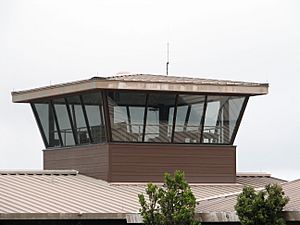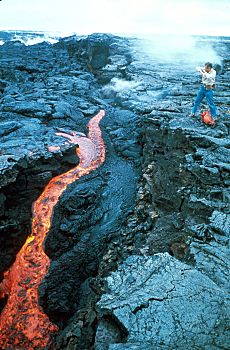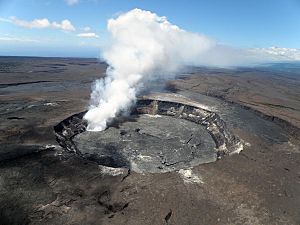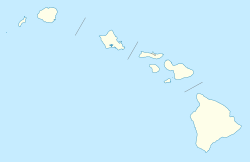Hawaiian Volcano Observatory facts for kids
 HVO observation tower, abandoned in 2018 after structural damage |
|
| Agency overview | |
|---|---|
| Formed | 1912 |
| Headquarters | Hilo, Hawaii, U.S. |
| Agency executive |
|
| Website | https://www.usgs.gov/observatories/hvo |
The Hawaiian Volcano Observatory (HVO) is a special science center. It is part of the United States Geological Survey (USGS). HVO is one of five volcano observatories in the U.S. that watch volcanoes.
HVO is located in Hilo, Hawaii, on the Island of Hawaiʻi. Its main job is to keep an eye on six Hawaiian volcanoes. These include Kīlauea, Mauna Loa, and Hualālai. Kīlauea and Mauna Loa are the most active ones. HVO is known worldwide for its great work studying active volcanoes.
For many years, scientists could safely study eruptions from their offices. These offices were near the Kīlauea volcano. But in 2018, the summit of Kīlauea collapsed. This event damaged the observatory buildings. Because of the damage, the buildings were taken down in 2024. Since 2018, HVO has been working from temporary offices in Hilo. A new field office near Kīlauea is planned to be completed in early 2026. A new main HVO building in Hilo is planned to open in 2027.
History of the Observatory
|
Whitney Seismograph Vault No. 29
|
|
| Nearest city | Volcano, Hawaii |
|---|---|
| Area | 18 feet (5.5 m) by 17.5 feet (5.3 m) |
| Built | 1912 |
| NRHP reference No. | 74000292 |
| Added to NRHP | July 24, 1974 |
Long ago, people in Ancient Hawaii shared stories about volcanoes. Later, explorers like Rev. William Ellis wrote down what they saw. Another person, Titus Coan, recorded eruptions until 1881.
Scientists sometimes wondered if these old descriptions were accurate. In 1909, a geologist named Thomas Jaggar gave a talk in Honolulu. A businessman, Lorrin A. Thurston, approached him. Thurston wanted to build a full-time science observatory at Kīlauea. Local business people then formed the Hawaiian Volcano Research Association. They wanted to help support the observatory. George Lycurgus, who owned the Volcano House hotel, offered a spot next to his hotel.
In 1911 and 1912, small cabins were built. They were on the floor of the caldera near the active vent of Halemaʻumaʻu. But these cabins were hard to keep up. In 1912, MIT helped with $25,000 to build a stronger building. This money came from the Whitney family. The first science tools were put in a cellar. It was next to the Volcano House and called the Whitney Laboratory of Seismology.
Prisoners from a nearby camp dug out the area. They went through 5.5 feet of volcanic ash. Strong concrete walls supported a small building on top. Professor Fusakichi Omori from Japan helped design the first seismometers. These tools measure ground shaking. This special building is now a historic site. It was added to the National Register of Historic Places in 1974.

From 1912 to 1919, Thomas Jaggar ran the observatory himself. Many important events were recorded. But the team faced big challenges. For example, in 1913, an earthquake cracked a wall. Water then leaked inside. Windows let in too much sun, making the vault too hot.
In 1916, the national park opened. This brought more visitors, which bothered the scientists. But park rangers started giving public talks. A military camp replaced the prison that provided workers.
In 1919, Jaggar convinced the National Weather Service to take over HVO. In 1924, the United States Geological Survey (USGS) took charge. The USGS has run HVO ever since. There was a short time during the Great Depression when the National Park Service ran it.
The Volcano House hotel burned down in 1940. The old HVO building was then torn down. But the science tools in the vault were still used until 1961.
George Lycurgus wanted a new, bigger hotel. He convinced friends in Washington D.C. to build a larger HVO building. This new building was farther from the cliff. By 1942, it was called "Volcano Observatory and Naturalist Building." But during World War II, the military used it as their headquarters. HVO used the building from 1942 to 1948. Then it became the park headquarters, which it still is today.
About two miles west, in an area called Uwekahuna, a museum was built in 1927. The name means "the priest wept" in Hawaiian. This suggests it was a special place in the past. HVO moved there in 1948 after some changes to the building. This spot was even closer to Kīlauea's main vent. In 1985, a larger building was built for the observatory next to the old museum. The old building became a museum and public viewing area again.
In the mid-1980s, HVO started a project to update the map of Hawaiʻi island. Their main map, "Geologic Map of the Island of Hawaiʻi," was published in 1996.
Who Leads HVO?
The scientist-in-charge has three main jobs. They manage money and equipment to keep things running smoothly. They tell staff how to watch and respond to volcanic events. They also share information with the public.
- HVO Directors
- 1912 to 1940, Thomas Jaggar
- 1940 to 1951, Ruy Finch
- 1951 to 1955, Gordon A. Macdonald
- 1956 to 1958, Jerry P. Eaton
- HVO Scientists-in-Charge
- 1958 to 1960, Kiguma Jack Murata
- 1960 to 1961, Jerry P. Eaton
- 1961 to 1962, Donald H. Richter
- 1962 to 1963, James G. Moore
- 1964 to 1970, Howard A. Powers
- 1970 to 1975, Donald W. Peterson
- 1975 to 1976, Robert I. Tilling
- 1976 to 1978, Gordon P. Eaton
- 1978 to 1979, Donald W. Peterson
- 1979 to 1984, Robert W. Decker
- 1984 to 1991, Thomas L. Wright
- 1991 to 1996, David A. Clague
- 1996 to 1997, Margaret T. Mangan
- 1997 to 2004, Donald A. Swanson
- 2004 to 2015, James P. Kauahikaua
- 2015 to 2020, Christina Neal
- 2021 to present, Ken Hon
How HVO Works
The Hawaiian Volcano Observatory has a huge network of sensors. Over 100 stations send data 24 hours a day. This information is put online right away. You can also see live videos of eruptions from webcams on HVO's website.
Another important job for HVO is watching sulfur gas. This gas creates volcanic pollution called vog. The observatory tells the park service when to close areas. They do this to keep people safe from vog and other volcano dangers.
The main observatory building was not open to the public. But the nearby Thomas A. Jaggar Museum was. It had exhibits about the work done at HVO. You could learn about volcanoes, lava, and the tools scientists use. Some windows in the museum offered a safe view of Halemaʻumaʻu and the Kīlauea Caldera. There was also a public viewing deck.
On May 10, 2018, Hawaii Volcanoes National Park closed parts of the Kīlauea summit area. This included the visitor center and park headquarters. It was due to explosions, earthquakes, and ash clouds from Halemaʻumaʻu. Much of the park reopened on September 22, 2018. However, the old observatory building and Jaggar Museum were closed forever. They had too much damage. In 2024, both the Observatory building and the Jaggar Museum were torn down.
In 2019, HVO received nearly 70 million dollars from the government. They used this money to find a new place to work. In April 2019, there was talk about moving staff to Oʻahu. But in August 2019, it was decided to find a new permanent spot in Hilo. This would replace the temporary offices. A new HVO field office is planned to be completed inside Hawaiʻi Volcanoes National Park in early 2026. A new main office building is planned to be finished in 2027. It will be on the University of Hawaiʻi at Hilo campus.
See also
 In Spanish: Observatorio Vulcanológico de Hawái para niños
In Spanish: Observatorio Vulcanológico de Hawái para niños




